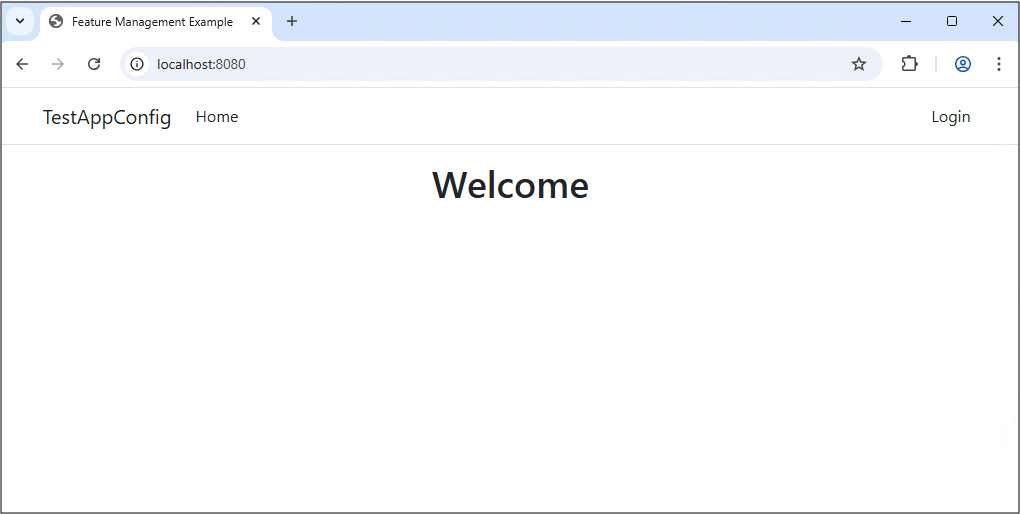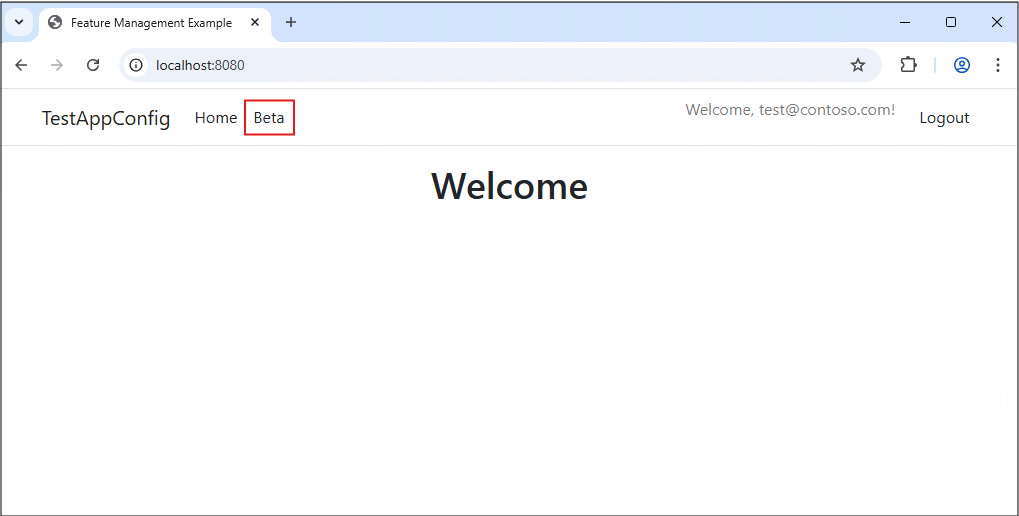Note
Access to this page requires authorization. You can try signing in or changing directories.
Access to this page requires authorization. You can try changing directories.
In this guide, you'll use the targeting filter to roll out a feature to targeted audiences for your Go Gin web application. For more information about the targeting filter, see Roll out features to targeted audiences.
Prerequisites
- An Azure account with an active subscription. Create one for free.
- An App Configuration store, as shown in the tutorial for creating a store.
- A feature flag with targeting filter. Create the feature flag.
- Go 1.21 or later. For information on installing Go, see the Go downloads page.
- Azure App Configuration Go provider v1.1.0-beta.1 or later.
Create a web application with a feature flag
In this section, you create a web application that allows users to sign in and use the Beta feature flag you created before.
Create a new directory for your Go project and navigate into it:
mkdir gin-targeting-quickstart cd gin-targeting-quickstartInitialize a new Go module:
go mod init gin-targeting-quickstartInstall the required Go packages:
go get github.com/gin-gonic/gin go get github.com/gin-contrib/sessions go get github.com/gin-contrib/sessions/cookie go get github.com/microsoft/Featuremanagement-Go/featuremanagement go get github.com/microsoft/Featuremanagement-Go/featuremanagement/providers/azappconfigCreate a templates directory for your HTML templates:
mkdir templatesCreate an HTML template for the home page. Add the following content to
templates/index.html:<!DOCTYPE html> <html lang="en"> <head> <meta charset="UTF-8"> <meta name="viewport" content="width=device-width, initial-scale=1.0"> <title>{{.title}}</title> <link href="https://cdn.jsdelivr.net/npm/bootstrap@5.1.3/dist/css/bootstrap.min.css" rel="stylesheet"> </head> <body> <nav class="navbar navbar-expand-sm navbar-toggleable-sm navbar-light bg-white border-bottom box-shadow mb-3"> <div class="container"> <a class="navbar-brand" href="/">TestFeatureFlags</a> <button class="navbar-toggler" type="button" data-bs-toggle="collapse" data-bs-target=".navbar-collapse" aria-controls="navbarSupportedContent" aria-expanded="false" aria-label="Toggle navigation"> <span class="navbar-toggler-icon"></span> </button> <div class="navbar-collapse collapse d-sm-inline-flex justify-content-between"> <ul class="navbar-nav flex-grow-1"> <li class="nav-item"> <a class="nav-link text-dark" href="/">Home</a> </li> {{if .betaEnabled}} <li class="nav-item"> <a class="nav-link text-dark" href="/beta">Beta</a> </li> {{end}} </ul> <ul class="navbar-nav"> {{if .user}} <li class="nav-item"> <span class="navbar-text me-3">Welcome, {{.user}}!</span> </li> <li class="nav-item"> <a class="nav-link text-dark" href="/logout">Logout</a> </li> {{else}} <li class="nav-item"> <a class="nav-link text-dark" href="/login">Login</a> </li> {{end}} </ul> </div> </div> </nav> <div class="container"> <div class="row justify-content-center"> <div class="col-md-8 text-center"> <h1>Welcome</h1> </div> </div> <script src="https://cdn.jsdelivr.net/npm/bootstrap@5.1.3/dist/js/bootstrap.bundle.min.js"></script> </body> </html>Create an HTML template for the beta page. Add the following content to
templates/beta.html:<!DOCTYPE html> <html lang="en"> <head> <meta charset="UTF-8"> <meta name="viewport" content="width=device-width, initial-scale=1.0"> <title>{{.title}}</title> <link href="https://cdn.jsdelivr.net/npm/bootstrap@5.1.3/dist/css/bootstrap.min.css" rel="stylesheet"> </head> <body> <!-- Navigation --> <nav class="navbar navbar-expand-sm navbar-toggleable-sm navbar-light bg-white border-bottom box-shadow mb-3"> <div class="container"> <a class="navbar-brand" href="/">TestFeatureFlags</a> <div class="navbar-collapse collapse d-sm-inline-flex justify-content-between"> <ul class="navbar-nav flex-grow-1"> <li class="nav-item"> <a class="nav-link text-dark" href="/">Home</a> </li> <li class="nav-item"> <a class="nav-link text-dark" href="/beta">Beta</a> </li> </ul> <ul class="navbar-nav"> <li class="nav-item"> <a class="nav-link text-dark" href="/logout">Logout</a> </li> </ul> </div> </div> </nav> <div class="container"> <div class="row justify-content-center"> <div class="col-md-8 text-center"> <h1>This is the beta website.</h1> </div> </div> </div> <script src="https://cdn.jsdelivr.net/npm/bootstrap@5.1.3/dist/js/bootstrap.bundle.min.js"></script> </body> </html>Create an HTML template for the login page. Add the following content to
templates/login.html:<!DOCTYPE html> <html lang="en"> <head> <meta charset="UTF-8"> <meta name="viewport" content="width=device-width, initial-scale=1.0"> <title>{{.title}}</title> <link href="https://cdn.jsdelivr.net/npm/bootstrap@5.1.3/dist/css/bootstrap.min.css" rel="stylesheet"> </head> <body> <nav class="navbar navbar-expand-sm navbar-toggleable-sm navbar-light bg-white border-bottom box-shadow mb-3"> <div class="container"> <a class="navbar-brand" href="/">TestFeatureFlags</a> <div class="navbar-collapse collapse d-sm-inline-flex justify-content-between"> <ul class="navbar-nav flex-grow-1"> <li class="nav-item"> <a class="nav-link text-dark" href="/">Home</a> </li> </ul> </div> </div> </nav> <div class="container"> <div class="row justify-content-center"> <div class="col-md-6"> <div class="card"> <div class="card-header"> <h3 class="text-center">Login</h3> </div> <div class="card-body"> {{if .error}} <div class="alert alert-danger" role="alert"> {{.error}} </div> {{end}} <form method="post" action="/login"> <div class="mb-3"> <input type="text" class="form-control" id="username" name="username" required placeholder="Enter you email"> </div> <div class="d-grid"> <button type="submit" class="btn btn-primary">Login</button> </div> </form> </div> </div> </div> </div> </div> <script src="https://cdn.jsdelivr.net/npm/bootstrap@5.1.3/dist/js/bootstrap.bundle.min.js"></script> </body> </html>
Connect to App Configuration
Create a file named appconfig.go with the following content. You can connect to your App Configuration store using Microsoft Entra ID (recommended) or a connection string.
package main
import (
"context"
"log"
"os"
"github.com/Azure/AppConfiguration-GoProvider/azureappconfiguration"
"github.com/Azure/azure-sdk-for-go/sdk/azidentity"
)
func loadAzureAppConfiguration(ctx context.Context) (*azureappconfiguration.AzureAppConfiguration, error) {
// Get the endpoint from environment variable
endpoint := os.Getenv("AZURE_APPCONFIG_ENDPOINT")
if endpoint == "" {
log.Fatal("AZURE_APPCONFIG_ENDPOINT environment variable is not set")
}
// Create a credential using DefaultAzureCredential
credential, err := azidentity.NewDefaultAzureCredential(nil)
if err != nil {
log.Fatalf("Failed to create credential: %v", err)
}
// Set up authentication options with endpoint and credential
authOptions := azureappconfiguration.AuthenticationOptions{
Endpoint: endpoint,
Credential: credential,
}
// Set up options to enable feature flags
options := &azureappconfiguration.Options{
FeatureFlagOptions: azureappconfiguration.FeatureFlagOptions{
Enabled: true,
RefreshOptions: azureappconfiguration.RefreshOptions{
Enabled: true,
},
},
}
// Load configuration from Azure App Configuration
appConfig, err := azureappconfiguration.Load(ctx, authOptions, options)
if err != nil {
log.Fatalf("Failed to load configuration: %v", err)
}
return appConfig, nil
}
Use targeting with feature flags
Create a file named
main.gowith the following content.package main import ( "context" "fmt" "log" "net/http" "strings" "github.com/gin-contrib/sessions" "github.com/gin-contrib/sessions/cookie" "github.com/gin-gonic/gin" "github.com/microsoft/Featuremanagement-Go/featuremanagement" "github.com/microsoft/Featuremanagement-Go/featuremanagement/providers/azappconfig" ) type WebApp struct { featureManager *featuremanagement.FeatureManager appConfig *azureappconfiguration.AzureAppConfiguration } func main() { // Load Azure App Configuration appConfig, err := loadAzureAppConfiguration(context.Background()) if err != nil { log.Fatalf("Error loading Azure App Configuration: %v", err) } // Create feature flag provider featureFlagProvider, err := azappconfig.NewFeatureFlagProvider(appConfig) if err != nil { log.Fatalf("Error creating feature flag provider: %v", err) } // Create feature manager featureManager, err := featuremanagement.NewFeatureManager(featureFlagProvider, nil) if err != nil { log.Fatalf("Error creating feature manager: %v", err) } // Create web app app := &WebApp{ featureManager: featureManager, appConfig: appConfig, } // Setup Gin with default middleware (Logger and Recovery) r := gin.Default() // Start server if err := r.Run(":8080"); err != nil { log.Fatalf("Failed to start server: %v", err) } fmt.Println("Starting server on http://localhost:8080") fmt.Println("Open http://localhost:8080 in your browser") fmt.Println() }Enable configuration and feature flag refresh from Azure App Configuration with the middleware.
// Existing code // ... ... func (app *WebApp) refreshMiddleware() gin.HandlerFunc { return func(c *gin.Context) { go func() { if err := app.appConfig.Refresh(context.Background()); err != nil { log.Printf("Error refreshing configuration: %v", err) } }() c.Next() } } func (app *WebApp) featureMiddleware() gin.HandlerFunc { return func(c *gin.Context) { // Get current user from session session := sessions.Default(c) username := session.Get("username") var betaEnabled bool var targetingContext featuremanagement.TargetingContext if username != nil { // Evaluate Beta feature with targeting context var err error targetingContext = createTargetingContext(username.(string)) betaEnabled, err = app.featureManager.IsEnabledWithAppContext("Beta", targetingContext) if err != nil { log.Printf("Error checking Beta feature with targeting: %v", err) } } c.Set("betaEnabled", betaEnabled) c.Set("user", username) c.Set("targetingContext", targetingContext) c.Next() } } // Helper function to create TargetingContext func createTargetingContext(userID string) featuremanagement.TargetingContext { targetingContext := featuremanagement.TargetingContext{ UserID: userID, Groups: []string{}, } if strings.Contains(userID, "@") { parts := strings.Split(userID, "@") if len(parts) == 2 { targetingContext.Groups = append(targetingContext.Groups, parts[1]) // Add domain as group } } return targetingContext } // The rest of existing code //... ...Set up the routes with the following content:
// Existing code // ... ... func (app *WebApp) setupRoutes(r *gin.Engine) { // Setup sessions store := cookie.NewStore([]byte("secret-key-change-in-production")) store.Options(sessions.Options{ MaxAge: 3600, // 1 hour HttpOnly: true, Secure: false, // Set to true in production with HTTPS }) r.Use(sessions.Sessions("session", store)) r.Use(app.refreshMiddleware()) r.Use(app.featureMiddleware()) // Load HTML templates r.LoadHTMLGlob("templates/*.html") // Routes r.GET("/", app.homeHandler) r.GET("/beta", app.betaHandler) r.GET("/login", app.loginPageHandler) r.POST("/login", app.loginHandler) r.GET("/logout", app.logoutHandler) } // Home page handler func (app *WebApp) homeHandler(c *gin.Context) { betaEnabled := c.GetBool("betaEnabled") user := c.GetString("user") c.HTML(http.StatusOK, "index.html", gin.H{ "title": "TestFeatureFlags", "betaEnabled": betaEnabled, "user": user, }) } // Beta page handler func (app *WebApp) betaHandler(c *gin.Context) { betaEnabled := c.GetBool("betaEnabled") if !betaEnabled { return } c.HTML(http.StatusOK, "beta.html", gin.H{ "title": "Beta Page", }) } func (app *WebApp) loginPageHandler(c *gin.Context) { c.HTML(http.StatusOK, "login.html", gin.H{ "title": "Login", }) } func (app *WebApp) loginHandler(c *gin.Context) { username := c.PostForm("username") // Basic validation - ensure username is not empty if strings.TrimSpace(username) == "" { c.HTML(http.StatusOK, "login.html", gin.H{ "title": "Login", "error": "Username cannot be empty", }) return } // Store username in session - any valid username is accepted session := sessions.Default(c) session.Set("username", username) session.Save() c.Redirect(http.StatusFound, "/") } func (app *WebApp) logoutHandler(c *gin.Context) { session := sessions.Default(c) session.Clear() session.Save() c.Redirect(http.StatusFound, "/") } // The rest of existing code //... ...Update the
main.gowith the following content:// Existing code // ... ... r := gin.Default() // Setup routes app.setupRoutes(r) // Start server if err := r.Run(":8080"); err != nil { log.Fatalf("Failed to start server: %v", err) } // The rest of existing code // ... ...After completing the previous steps, your
main.gofile should now contain the complete implementation as shown below:package main import ( "context" "fmt" "log" "net/http" "strings" "github.com/gin-contrib/sessions" "github.com/gin-contrib/sessions/cookie" "github.com/gin-gonic/gin" "github.com/microsoft/Featuremanagement-Go/featuremanagement" "github.com/microsoft/Featuremanagement-Go/featuremanagement/providers/azappconfig" ) type WebApp struct { featureManager *featuremanagement.FeatureManager appConfig *azureappconfiguration.AzureAppConfiguration } func (app *WebApp) refreshMiddleware() gin.HandlerFunc { return func(c *gin.Context) { go func() { if err := app.appConfig.Refresh(context.Background()); err != nil { log.Printf("Error refreshing configuration: %v", err) } }() c.Next() } } func (app *WebApp) featureMiddleware() gin.HandlerFunc { return func(c *gin.Context) { // Get current user from session session := sessions.Default(c) username := session.Get("username") var betaEnabled bool var targetingContext featuremanagement.TargetingContext if username != nil { // Evaluate Beta feature with targeting context var err error targetingContext = createTargetingContext(username.(string)) betaEnabled, err = app.featureManager.IsEnabledWithAppContext("Beta", targetingContext) if err != nil { log.Printf("Error checking Beta feature with targeting: %v", err) } } c.Set("betaEnabled", betaEnabled) c.Set("user", username) c.Set("targetingContext", targetingContext) c.Next() } } // Helper function to create TargetingContext func createTargetingContext(userID string) featuremanagement.TargetingContext { targetingContext := featuremanagement.TargetingContext{ UserID: userID, Groups: []string{}, } if strings.Contains(userID, "@") { parts := strings.Split(userID, "@") if len(parts) == 2 { targetingContext.Groups = append(targetingContext.Groups, parts[1]) // Add domain as group } } return targetingContext } func (app *WebApp) setupRoutes(r *gin.Engine) { // Setup sessions store := cookie.NewStore([]byte("secret-key-change-in-production")) store.Options(sessions.Options{ MaxAge: 3600, // 1 hour HttpOnly: true, Secure: false, // Set to true in production with HTTPS }) r.Use(sessions.Sessions("session", store)) r.Use(app.refreshMiddleware()) r.Use(app.featureMiddleware()) // Load HTML templates r.LoadHTMLGlob("templates/*.html") // Routes r.GET("/", app.homeHandler) r.GET("/beta", app.betaHandler) r.GET("/login", app.loginPageHandler) r.POST("/login", app.loginHandler) r.GET("/logout", app.logoutHandler) } // Home page handler func (app *WebApp) homeHandler(c *gin.Context) { betaEnabled := c.GetBool("betaEnabled") user := c.GetString("user") c.HTML(http.StatusOK, "index.html", gin.H{ "title": "TestFeatureFlags", "betaEnabled": betaEnabled, "user": user, }) } // Beta page handler func (app *WebApp) betaHandler(c *gin.Context) { betaEnabled := c.GetBool("betaEnabled") if !betaEnabled { return } c.HTML(http.StatusOK, "beta.html", gin.H{ "title": "Beta Page", }) } func (app *WebApp) loginPageHandler(c *gin.Context) { c.HTML(http.StatusOK, "login.html", gin.H{ "title": "Login", }) } func (app *WebApp) loginHandler(c *gin.Context) { username := c.PostForm("username") // Basic validation - ensure username is not empty if strings.TrimSpace(username) == "" { c.HTML(http.StatusOK, "login.html", gin.H{ "title": "Login", "error": "Username cannot be empty", }) return } // Store username in session - any valid username is accepted session := sessions.Default(c) session.Set("username", username) session.Save() c.Redirect(http.StatusFound, "/") } func (app *WebApp) logoutHandler(c *gin.Context) { session := sessions.Default(c) session.Clear() session.Save() c.Redirect(http.StatusFound, "/") } func main() { // Load Azure App Configuration appConfig, err := loadAzureAppConfiguration(context.Background()) if err != nil { log.Fatalf("Error loading Azure App Configuration: %v", err) } // Create feature flag provider featureFlagProvider, err := azappconfig.NewFeatureFlagProvider(appConfig) if err != nil { log.Fatalf("Error creating feature flag provider: %v", err) } // Create feature manager featureManager, err := featuremanagement.NewFeatureManager(featureFlagProvider, nil) if err != nil { log.Fatalf("Error creating feature manager: %v", err) } // Create web app app := &WebApp{ featureManager: featureManager, appConfig: appConfig, } // Setup Gin with default middleware (Logger and Recovery) r := gin.Default() // Setup routes app.setupRoutes(r) // Start server if err := r.Run(":8080"); err != nil { log.Fatalf("Failed to start server: %v", err) } fmt.Println("Starting server on http://localhost:8080") fmt.Println("Open http://localhost:8080 in your browser") fmt.Println() }
Targeting filter in action
Set the environment variable for authentication and run the application:
go mod tidy go run .Open a browser window, and go to
http://localhost:8080. Initially, the Beta item doesn't appear on the toolbar, because the Default percentage option is set to 0.
Click the Login link in the upper right corner. Try logging in with
test@contoso.com.After logging in as
test@contoso.com, the Beta item now appears on the toolbar, becausetest@contoso.comis specified as a targeted user.
Now logout and login as
testuser@contoso.com. The Beta item doesn't appear on the toolbar, becausetestuser@contoso.comis specified as an excluded user.
Next steps
To learn more about the feature filters, continue to the following documents.
For more information about the Go Feature Management library, continue to the following document: